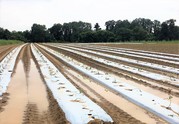
Signup began January 23 for additional emergency relief from the U.S. Department of Agriculture (USDA) through the Emergency Relief Program (ERP) Phase Two.
To be eligible for Phase Two, producers must have suffered a decrease in allowable gross revenue in 2020 or 2021 due to necessary expenses related to losses of eligible crops from a qualifying natural disaster event. Eligible crops include both traditional insurable commodities and specialty crops that are produced in the United States as part of a farming operation and are intended to be commercially marketed. This also includes losses of eligible on-farm stored commodities. ERP Phase 2 applicants will use the following tax years when selecting allowable gross revenue:
- Benchmark years: 2018 and/or 2019; estimated for new producers with no 2018 or 2019 revenue or adjusted if the benchmark years are not representative of the disaster year due to a change in operation size.
- Disaster years: 2020 and/or 2021. The allowable gross revenue for the specific disaster year will be based on the tax year applicable to that revenue (2020, 2021 or 2022).
The ERP tool assists producers in calculating allowable gross revenue, as well as adjusted revenue for the benchmark years 2018 and 2019, and allowable gross revenue for representative tax years 2020-2022 which represent disaster years 2020 and 2021. Once producers complete the allowable gross revenue entries, they are able to print forms FSA-521 and FSA-521A through this tool.
The ERP Phase 2 and PARP application period is open from January 23 through June 2 2023.
For more information on payment calculations, payment limitations or how to determine allowable gross revenue, please reference the ERP Phase 2 fact sheet.
|

The Pandemic Assistance Revenue Program (PARP) will assist eligible producers of agricultural commodities who experienced revenue decreases in calendar year 2020 compared to 2018 or 2019 due to the COVID-19 pandemic. PARP will help address gaps in previous pandemic assistance, which was targeted at price loss or lack of market access, rather than overall revenue losses.
USDA's Farm Service Agency will accept PARP applications from January 23, 2023, through June 2, 2023.
Eligible and Ineligible Commodities
For PARP, eligible agricultural commodities include crops, aquaculture, livestock, livestock byproducts, or other animals or animal byproducts that are produced as part of a farming operation and are intended to be commercially marketed. This includes only commodities produced in the United States or those produced outside the United States by a producer located in the United States and marketed inside the United States.
The following commodities are not eligible for PARP:
- Wild free-roaming animals.
- Horses and other animals used or intended to be used for racing or wagering.
- Aquatic species that do not meet the definition of aquaculture.
-
Cannabis sativa L.and any part of that plant that does not meet the definition of hemp.
- Timber
Program Eligibility
PARP payments will be made on a whole-farm basis, not commodity-by-commodity. To be eligible for PARP, an agricultural producer must have been in the business of farming during at least part of the 2020 calendar year and must have experienced a 15 percent decrease in allowable gross revenue in 2020, as compared to either:
- The 2018 or 2019 calendar year, as elected by the producer, if they received allowable gross revenue during the 2018 or 2019 calendar years, or
- The producer’s expected 2020 calendar year allowable gross revenue, if the producer had no allowable gross revenue in 2018 or 2019.
PARP payments will be issued after the application period ends on June 2, 2023.
For more information on determining allowable gross revenue visit farmers.gov/coronavirus/pandemic-assistance/parp or review the PARP fact sheet.
More Information
To apply for PARP, contact your local USDA Service Center.
|

The Farm Service Agency (FSA) is accepting offers for specific conservation practices under the Conservation Reserve Program (CRP) Continuous Signup.
In exchange for a yearly rental payment, farmers enrolled in the program agree to remove environmentally sensitive land from agricultural production and to plant species that will improve environmental health and quality. The program’s long-term goal is to re-establish valuable land cover to improve water quality, prevent soil erosion, and reduce loss of wildlife habitat. Contracts for land enrolled in CRP are 10-15 years in length.
Under continuous CRP signup, environmentally sensitive land devoted to certain conservation practices can be enrolled in CRP at any time. Offers for continuous enrollment are not subject to competitive bidding during specific periods. Instead they are automatically accepted provided the land and producer meet certain eligibility requirements and the enrollment levels do not exceed the statutory cap.
For more information, including a list of acceptable practices, contact your Kent County USDA Service Center at 616-942-4111 or visit fsa.usda.gov/crp.
Conservation at Work Video Series
A video series from NRCS and farmers.gov, Conservation at Work, presents short and easy to understand videos about popular conservation practices. These videos feature producers explaining how an individual practice helps their land and why they are using it.
The videos shine the spotlight on farmers, ranchers, and forestland owners from across the U.S. who explain why they’ve implemented the conservation practices and how they work on their land. They also provide insight into how each practice is helping them protect and improve resources and save time and money.
We’ve got videos showcasing high tunnels, no-till, cover crops, prescribed grazing, and many more.
Check out the Conservation at Work video series at farmers.gov/conserve/conservationatwork.
|

|
FSA offers online resources that can help producers understand our programs.
The Loan Discovery Tool helps producers find a USDA Farm Loan that might be right for them by answering a few short questions. They can also lean about their eligibility and find application guides to help them prepare for their USDA Service Center visit with a loan officer.
The Loan Assistance Tool allows producers to check their eligibility for FSA loans, discover the various FSA loan products, learn about documentation requirements, and follow easy-to-understand instructions when completing the loan application forms.
The Direct Loan Application was developed to provide an improved customer experience for producers applying for loans from FSA. The simplified direct loan application provides all loan applicants access to information regarding the application process and assists them with gathering the correct documents before they begin the process.
The Your Guide to FSA Farm Loans guidebook simplifies information on the types of farm loans available; how to apply for a guaranteed loan, direct loan, or land contract guarantee; what you can expect once you submit your application; and most importantly, your rights and responsibilities as an FSA customer.
The Your FSA Farm Loan Compass guidebook simplifies information regarding the responsibilities of FSA loan borrowers and the loan servicing options available to them.
Spanish language versions of the Your Guide to FSA Farm Loans and Your FSA Farm Loan Compass guidebooks are available as well.
|
|
If you’re a historically underserved producer and participating in the USDA’s Natural Resources Conservation Service’s (NRCS) Environmental Quality Incentives Program (EQIP), you can receive an advance conservation practice payment before you implement a practice.
A historically underserved producer is described as one of the below:
-
Beginning Farmer or Rancher – is new to farming or ranching, or, has operated a farm or ranch for less than 10-consecutive years.
-
Socially Disadvantaged Farmer or Rancher – is a member of a group whose members have been subjected to racial or ethnic prejudice because of their identity as members of that group without regard to their individual qualities.
-
Veteran Farmer or Rancher – has served in the armed forces and has not operated a farm or ranch, has operated a farm or ranch for less than 10-consecutive years, or first obtained veteran status during the last 10 years.
-
Limited Resource Farmer or Rancher – has a household income at or below the national poverty level. Eligibility can be determined by using this online tool.
Under the advance payment option, such producers may request payments when they have final designs and job sheets and are ready to begin their EQIP practices. Advance payments provide at least 50 percent of the payment rate for each practice. The funds must be spent within 90 days of receipt and practices must be completed as agreed to in an EQIP plan of operations. Producers also may opt to have NRCS pay the contractors or vendors directly.
For more information, visit the advance payments webpage where you can download the EQIP Advance Payment Fact Sheet.
Why are pollinators so important? That’s easy - Food. One out of three bites of food can be attributed to these important creatures – such as bees, butterflies, moths, birds, beetles, bats, and a few other small mammals. Pollinators provide crucial assistance to fruit, vegetable and seed crops as well as other plants that produce fiber, medicine and fuel. For many plants, without the help of pollinators, they would be unable to reproduce.
But as you may know, pollinators are in trouble. Many are seeing decreasing populations because of habitat loss, disease, parasites and pesticide use. But there’s good news. There are simple ways you can help. It can be as easy as selecting high-quality pollinator plants for your garden. To find the best plants for your area, visit the websites of NRCS partners at the Xerces Society Pollinator Conservation Program or Pollinator Partnership.
If you operate a farm or ranch, NRCS can help you create habitat for pollinators. This not only benefits pollinators, but also provides ample perks for the farmers and ranchers, too. More pollinators can increase crop yields. Pollinators can be increased by planting wildflowers in and around fields and choosing the right cover crops. NRCS offers more than three dozen conservation practices that assist in building healthier landscapes for pollinators. NRCS can also help fund the implementation of these practices.
Habitats used by pollinators attract beneficial insects (insects that eat crop pests), and they may provide habitat for other wildlife, reduce soil erosion, and improve water quality. As you can see, pollinators and healthy habitat for pollinators help keep the ecosystem healthy. In fact, if you are putting in conservation practices to prevent soil erosion or protect stream banks, consider including wildflowers, shrubs and trees that support pollinators.
For more information, contact your Kent County USDA Service Center at 616-942-4111 ext. 3 or visit
nrcs.usda.gov/pollinators.

Sometimes in a quest for bigger harvests, producers put every inch of land to work. But more land for crops or pastures doesn’t always lead to bigger yields. It’s best to use land for its greatest purpose, enabling more than a traditional yield. One common way producers do this through conservation is field borders. Field borders are managed strips of grass or legumes, sometimes mixed with shrubs, on the edge of cropland fields that reduce erosion, promote wildlife and improve environmental quality.
Field borders – typically 15 to 30 feet wide – make operating easy for farm equipment, providing a sod-based area at the edge of the field to turn machinery during field operations. They also help protect combines and other equipment from overhanging tree limbs. Field borders protect water quality by trapping sediment and nutrients, much like a filter. These planted areas, depending on their location, reduce erosion, and trap sediment and nutrients that can have negative effects downstream. They also slow water down as it runs off fields.
Properly managed field borders also increase plant diversity and the availability of food sources such as seeds and insects for bobwhite quail, cottontail rabbits, wild turkeys, gray fox and many other wildlife species. Many of these species like bobwhite quail have increased in population as field borders have been implemented. Not only can field borders serve as a wildlife-friendly practice, but they can be attractive features on farms.
For more information, contact your Kent County USDA Service Center at 616-942-4111 ext. 3 or visit nrcs.usda.gov.
|
|